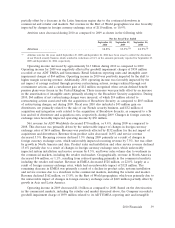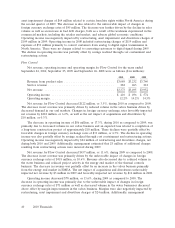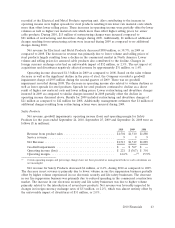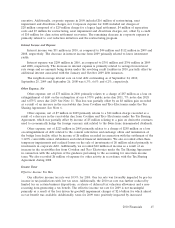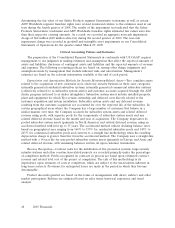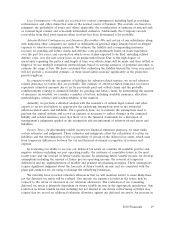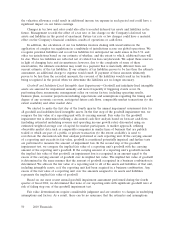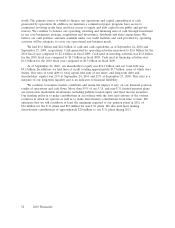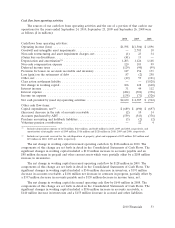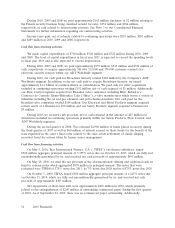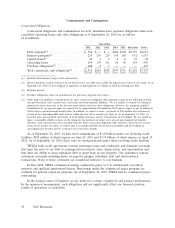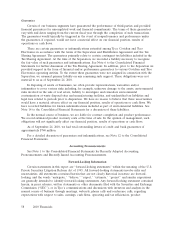ADT 2010 Annual Report Download - page 137
Download and view the complete annual report
Please find page 137 of the 2010 ADT annual report below. You can navigate through the pages in the report by either clicking on the pages listed below, or by using the keyword search tool below to find specific information within the annual report.Loss Contingencies—Accruals are recorded for various contingencies including legal proceedings,
self-insurance and other claims that arise in the normal course of business. The accruals are based on
judgment, the probability of losses and, where applicable, the consideration of opinions of internal and/
or external legal counsel and actuarially determined estimates. Additionally, the Company records
receivables from third party insurers when recovery has been determined to be probable.
Asbestos-Related Contingencies and Insurance Receivables—We and certain of our subsidiaries along
with numerous other companies are named as defendants in personal injury lawsuits based on alleged
exposure to asbestos-containing materials. We estimate the liability and corresponding insurance
recovery for pending and future claims and defense costs predominantly based on claim experience
over the past five years, and a projection which covers claims expected to be filed, including related
defense costs, over the next seven years on an undiscounted basis. Due to the high degree of
uncertainty regarding the pattern and length of time over which claims will be made and then settled or
litigated, we use multiple estimation methodologies based on varying scenarios of potential outcomes to
estimate the range of loss. We have concluded that estimating the liability beyond the seven year period
will not provide a reasonable estimate, as these uncertainties increase significantly as the projection
period lengthens.
In connection with the recognition of liabilities for asbestos-related matters, we record asbestos-
related insurance recoveries that are probable. The estimate of asbestos-related insurance recoveries
represents estimated amounts due to us for previously paid and settled claims and the probable
reimbursements relating to estimated liability for pending and future claims. In determining the amount
of insurance recoverable, we consider a number of factors, including available insurance, allocation
methodologies, solvency and creditworthiness of the insurers.
Annually, we perform a detailed analysis with the assistance of outside legal counsel and other
experts to review and update as appropriate the underlying assumptions used in the estimated
asbestos-related assets and liabilities. On a quarterly basis, we re-evaluate the assumptions used to
perform the annual analysis and record an expense as necessary to reflect changes in the estimated
liability and related insurance asset. See Note 14 to the financial statements for a discussion of
management’s judgments applied in the recognition and measurement of asbestos-related assets and
liabilities.
Income Taxes—In determining taxable income for financial statement purposes, we must make
certain estimates and judgments. These estimates and judgments affect the calculation of certain tax
liabilities and the determination of the recoverability of certain of the deferred tax assets, which arise
from temporary differences between the tax and financial statement recognition of revenue and
expense.
In evaluating our ability to recover our deferred tax assets we consider all available positive and
negative evidence including our past operating results, the existence of cumulative losses in the most
recent years and our forecast of future taxable income. In estimating future taxable income, we develop
assumptions including the amount of future pre-tax operating income, the reversal of temporary
differences and the implementation of feasible and prudent tax planning strategies. These assumptions
require significant judgment about the forecasts of future taxable income and are consistent with the
plans and estimates we are using to manage the underlying businesses.
We currently have recorded valuation allowances that we will maintain until it is more-likely-than-
not the deferred tax assets will be realized. Our income tax expense recorded in the future may be
reduced to the extent of decreases in our valuation allowances. The realization of our remaining
deferred tax assets is primarily dependent on future taxable income in the appropriate jurisdiction. Any
reduction in future taxable income including but not limited to any future restructuring activities may
require that we record an additional valuation allowance against our deferred tax assets. An increase in
2010 Financials 49


